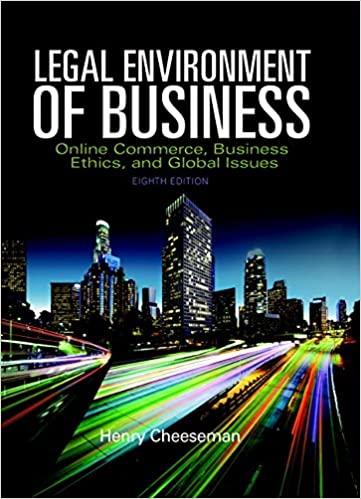Question
Case Study #4 Enslev v Challenges Unlimited Enslev was a case tried in the fall of 2007 in Ontario. It involved a claim by a
Case Study #4
Enslev v Challenges Unlimited
Enslev was a case tried in the fall of 2007 in Ontario. It involved a claim by a young woman who suffered very serious injuries in a fall from a swing on a "challenge course". The woman fell when the loop that secured her safety harness to the pendulum swing failed. The loop failed because the webbing from which it was made was weakened and cut because of friction from a "lazy line", a device used to return the harness to its staring position after the rider dismounted. The contact between the lazy line and the loop occurred because of operator error in routing the lazy line.
The plaintiff brought a lawsuit against the resort that offered the swing ride, and against the company that installed the challenge course at the resort. The contract between the two defendants, the resort and the supplier, contained a waiver: the resort management agreed that:
The risk of use of the Equipment shall be the sole responsibility of the Client [the resort]. For greater certainty, the Contractor [the supplier] assumes no liability for injury, loss or damage to any person or property, however caused, resulting from the equipment and materials and any authorised or unauthorised use of the Equipment.
The contract also provided that the resort was responsible for training operators of the equipment, and the resort did so with the help of a consultant and a trainer knowledgeable in the field.
After receiving the evidence, the court held that the resort was 100 percent liable for the plaintiff's injuries, and that the supplier was not liable. In finding only the resort liable, the court held that "a manufacturer cannot escape liability simply because the defect only causes injury when coupled with the negligence or other wrongdoing of the user or third party." However, there was nothing wrong with the equipment. The cutting of the loop by the lazy line was not reasonably foreseeable to the supplier (there had been no other accidents in 450,000 use cycles of similar equipment across Canada). Therefore, there was no duty of the supplier to build in a feature that would have prevented this accident. The court quoted the following statement of the limitations of product liability law from Canadian Tort Law:
The law does not impose strict liability on manufacturer so they are liable for all injuries caused by their goods no matter what the circumstances nor does it require a manufacturer to produce articles which are accident proof or incapable of doing harm.
The manufacturer is not an insurer of anyone who suffers injury while using or misusing a product.
In permitting its staff to set up and use the equipment improperly, the resort became entirely responsible for the plaintiff's injuries. For recreation providers, this decision is sobering reminder that product liability law will not save a recreation provider from liability where an accident occurs because of its staff's improper use of otherwise safe equipment.
- The facts (5 marks)
- The issue(s) (5 marks)
- Make sure it is in question format.
- The court's decision (1 mark)
- The court's reasoning supporting the decision (3 marks)
- Conclusion: Do you agree with the outcome? Why or why not? Justify your answer. (6 marks)
- Agree/not (1 mark)
- Why or why not (2 marks)
- Your own personal justification/rationale expanding on why or why not (3 marks)
- Agree/not (1 mark)
Step by Step Solution
There are 3 Steps involved in it
Step: 1

Get Instant Access to Expert-Tailored Solutions
See step-by-step solutions with expert insights and AI powered tools for academic success
Step: 2

Step: 3

Ace Your Homework with AI
Get the answers you need in no time with our AI-driven, step-by-step assistance
Get Started


